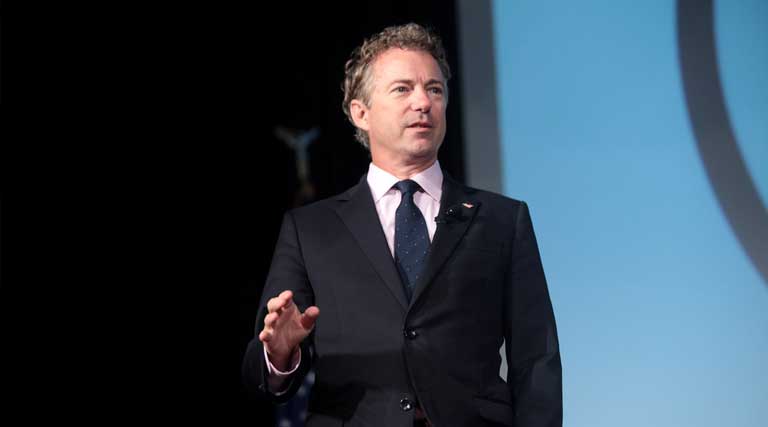Congress “Spent As Never Before, Doing So Ostensibly Without A Care” In 2020, Greatly Contributing To What Is Now A $3.1 Trillion Deficit.
Photo: Senator Rand Paul, R-Kentucky
Published January 8, 2021
The Center Square [By Bethany Blankley]-
Senator Rand Paul, R-Kentucky, argues in his annual wasteful spending report that Congress “spent as never before, doing so ostensibly without a care” in 2020, greatly contributing to what is now a $3.1 trillion deficit,
At the same time, initial 15-day lockdowns to stop the spread of the coronavirus turned into nearly year-long lockdowns, Paul said, “wreaking havoc on Americans’ health, sanity, and economy, while also empowering petty tyrants across the country.”
Some of the deficit is traceable to COVID-19-related spending, Paul said, “but a lot of it was not. For example, perhaps somebody can explain to me why … Congress reimbursed some agencies for money they had spent in late 2019 and early 2020, before COVID hit, on efforts unrelated to COVID?”
Paul suggested cutting agencies blank checks is why the debt skyrocketed from $23 trillion to more than $27 trillion. Congressional spending was 50% higher in 2020 than 2019, he said. Payments of interest on the public debt remained at $387 billion.
“If you laid out that many $1 bills end to end, it’d be enough to wrap around the Earth 1,506 times. And that’s money the government spends that doesn’t help anybody – doesn’t even buy a pen or a paper clip,” Paul said in the introduction to his report, which details how the federal government wasted $54.7 billion worth of taxpayer money.
Within that amount is $3.86 billion worth of health care spending that had nothing to do with the COVID-19 pandemic. Paul’s report outlined examples of taxpayer-funded National Institutes of Health studies that could have gone toward paying down the debt, not increasing it, including:
• $1.3 million to study whether people will eat ground-up bugs;
• $36 million to ask why stress makes peoples’ hair turn gray;
• $1.47 million to persuade Eastern Mediterranean youth to stop smoking hookah;
• $6.97 million of cancer research money to create a “smart toilet;”
• $1.24 million to reduce the amount of time adults spend watching TV;
• $896,994 to give cigarettes to adolescents;
• $3.45 million to send messages to mothers to encourage their teenage daughters to stop indoor tanning;
• $31.5 million on an allegedly faked study linking e-cigarettes to heart attacks;
• $3.1 million interviewing San Franciscans about their edible cannabis use;
• $2 million on testing if using a hot tub can lower stress;
• $968,932 on developing a master’s degree in research ethics in Myanmar;
• $3.69 million on the U.S. Food and Drug Administration’s Deeming Rule;
• $1 million on helping people get over their fear of going to the dentist;
• $1.45 million on studying the prevalence of party drug use at New York City clubs and raves; and
• $787,355 on studying the effect of sleepiness on diet, physical activity and obesity in children.
Other waste, according to Paul, in health care spending included funding federal employees’ duplicative Medicare customer service access of up to $217 million and waiting for years on delinquent undelivered orders at the Veterans Administration, costing taxpayers $3.49 billion.
In one of several audit reports published last year by Open The Books, one 24-page report analyzed “why, how, and where” federal agencies wasted tax dollars in 2019.
Its auditors found the most wasteful federal programs were Medicaid, Medicare and the Earned Income Tax Credit. In these three programs, 69% of the money spent – $121 billion – were improper payments.
Dead people received $871.9 million in mistaken payments through Medicaid, Social Security, federal pensions and farm subsidies because agencies primarily failed to verify deaths, the report said. Over four years, money sent to dead people has cost taxpayers $2.8 billion.
The $175 billion in taxpayer money provided through improper payments, Open the Books’ Adam Andrzejewski argued, could have paid for the equivalent of a full year of all federal salaries, perks and pension benefits for every employee of federal executive agencies.
Paul argued the $54 billion detailed in his report could have funded three years of the entire U.S. Treasury Department.





